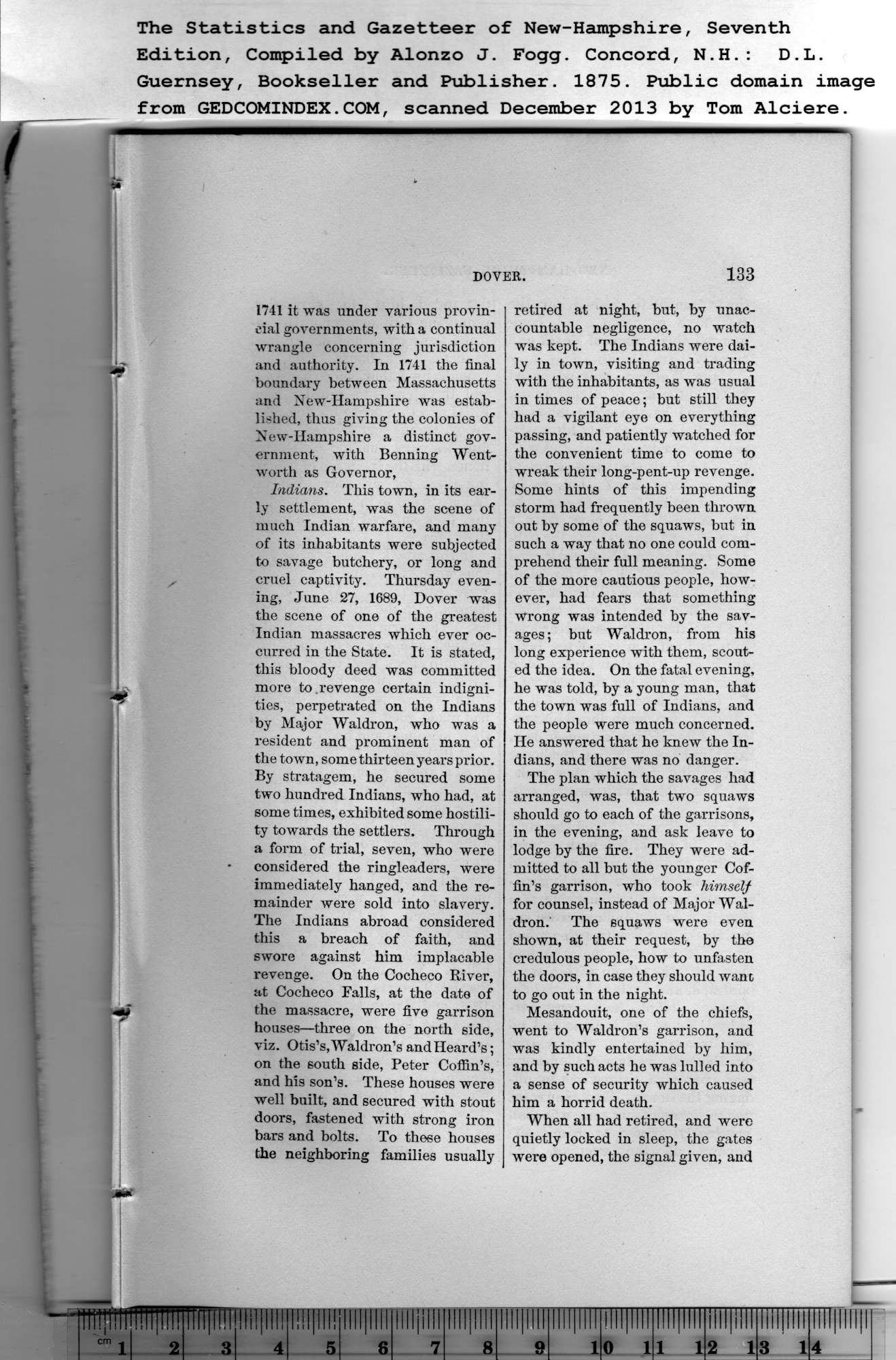|
1741 it was under various provin-
cial governments, with a continual
wrangle concerning jurisdiction
and authority. In 1741 the final
boundary between Massachusetts
and Xew-Hampshire was estab-
lished, thus giving the colonies of
Xew-Hampshire a distinct gov-
ernment, with Benning Went-
worth as Governor,
Indians. This town, in its ear-
ly settlement, was the scene of
much Indian warfare, and many
of its inhabitants were subjected
to savage butchery, or long and
cruel captivity. Thursday even-
ing, June 27, 1689, Dover was
the scene of one of the greatest
Indian massacres which ever oc-
curred in the State. It is stated,
this bloody deed was committed
more to.revenge certain indigni-
ties, perpetrated on the Indians
by Major Waldron, who was a
resident and prominent man of
the town, some thirteen years prior.
By stratagem, he secured some
two hundred Indians, who had, at
some times, exhibited some hostili-
ty towards the settlers. Through
a form of trial, seven, who were
considered the ringleaders, were
immediately hanged, and the re-
mainder were sold into slavery.
The Indians abroad considered
this a breach of faith, and
swore against him implacable
revenge. On the Cocheco River,
at Cocheco Falls, at the date of
the massacre, were five garrison
houses—three on the north side,
viz. Otis’s, Waldron’s and Heard’s;
on the south side, Peter Coffin’s,
and his son’s. These houses were
well built, and secured with stout
doors, fastened with strong iron
bars and bolts. To these houses
the neighboring families usually
retired at night, but, by unac-
countable negligence, no watch
was kept. The Indians were dai-
ly in town, visiting and trading
with the inhabitants, as was usual
in times of peace; but still they
had a vigilant eye on everything
passing, and patiently watched for
the convenient time to come to
wreak their long-pent-up revenge.
Some hints of this impending
storm had frequently been thrown
out by some of the squaws, but in
such a way that no one could com-
prehend their full meaning. Some
of the more cautious people, how-
ever, had fears that something
Wrong was intended by the sav-
ages; but Waldron, from his
long experience with them, scout-
ed the idea. On the fatal evening,
he was told, by a young man, that
the town was full of Indians, and
the people were much concerned.
He answered that he knew the In-
dians, and there was no danger.
|
The plan which the savages had
arranged, was, that two squaws
should go to each of the garrisons,
in the evening, and ask leave to
lodge by the fire. They were ad-
mitted to all hut the younger Cof-
fin’s garrison, who took himself
for counsel, instead of Major Wal-
dron. The squaws were even
shown, at their request, by the
credulous people, how to unfasten
the doors, in case they should wane
to go out in the night.
Mesandouit, one of the chiefs,
went to Waldron’s garrison, and
was kindly entertained by him,
and by such acts he was lulled into
a sense of security which caused
him a horrid death.
When all had retired, and were
quietly locked in sleep, the gates
were opened, the signal given, and |
